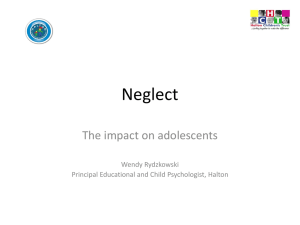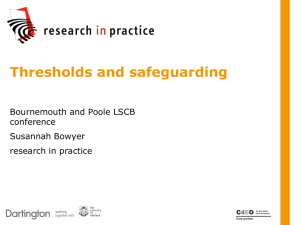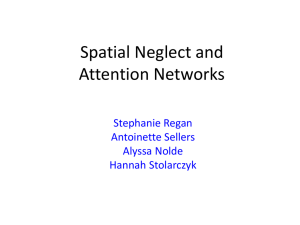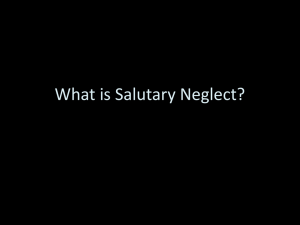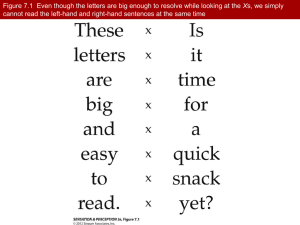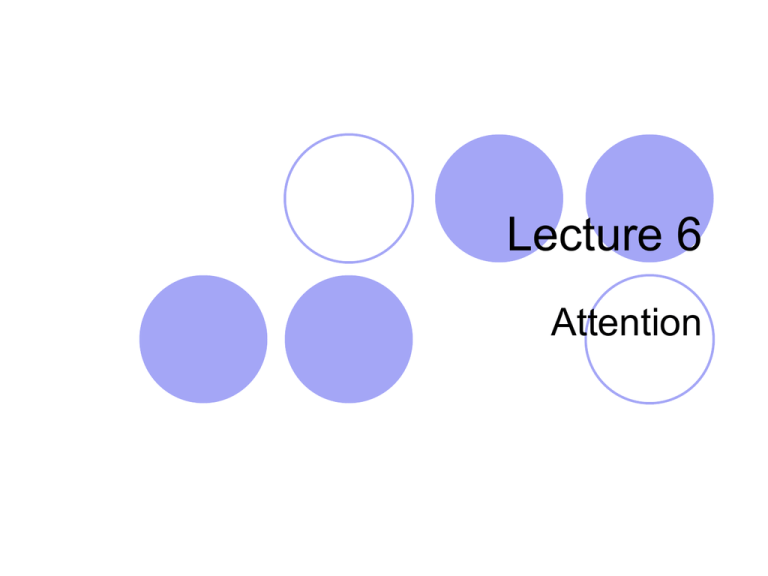
Lecture 6
Attention
What is Attention?
“Everyone knows what attention is. It is the taking of
possession by the mind, in clear and vivid form, of one out
of what seem several simultaneously possible objects or
trains of thought. Focalization, concentration of
consciousness are of its essence. It implies withdrawal
from some things in order to deal effectively with others,
and is a condition which has a real opposite in the
confused, dazed, scatterbrain state…”
William James (1890)
“the nature of God is like a circle of which the center is
everywhere and the circumference is nowhere”
Empedocles (500 B.C.E.)
What is Attention?
It is more than just sensation and perception
Attention and arousal are not synonymous
There can be attentional deficits in perfectly
awake individuals
Extreme arousal (as in pain or terror) may
impair the flexibility of attention
What is Attention?
Attention: ability to detect and respond to stimuli
Attention is not a unitary construct
just like memory there are many different types of
attention
At the psychological level: attention implies a
preferential allocation of processing resources
and response channels to events that have
become behaviorally relevant
At the neural level: attention refers to
alternations in the selectivity, intensity and
duration of neuronal responses to such events
Types of Attention
1. Alertness and arousal – the basic aspects of attention
that enable a person to extract information from the
environment or to select a particular response (e.g.,
coma, stupor, awake, full alertness)
2. Vigilance (sustained attention) – the ability to sustain
alertness (monitor an even or stimulus) continuously
(e.g., waiting at a traffic light and waiting for a change
from red light to green light)
3. Selective attention – the aspect of attention that is
used to select either specific incoming information or
specific responses for priority in processing (e.g.,
attending to one conversation at a party and ignoring
others or the music)
Bottom-up and Top-down Processes
Bottom-up processing – processing that
starts with unprocessed sensory
information and builds toward more
conceptual representation
Top-down processing – processing in
which conceptual knowledge influences
the processing or interpretation of lower
level perceptual processing
Neurophysiology of Attentional Matrix
1.
2.
3.
4.
5.
6.
Reticular activating system
The superior colliculus
The thalamus
The parietal lobe
The frontal lobe
The cingulate cortex
The Reticular Activating System (RAS)
Arousal and wakefulness
Sleep-wake cycle
Cells in the reticular formation can set the pace
of activity of cells throughout the brain
Damage to the RAS can produce reduced
attention – confusional state or coma
Coma – an impaired state of consciousness in
which individuals are seeming unresponsive to
most external stimuli
Coma can arise after a bilateral damage to RAS
or interrupted communication between the RAS
and the rest of the brain
Causes: tumor, strokes, seizures, carbon
monoxide etc.
Chronic coma chronic vegetative state
Coming out of the coma stupor – in and out
of consciousness
Stimulants and depressants have an effect on
the RAS system
The Superior Colliculus
This structure is important for directing
visual attention to ‘novel’ stimuli
Looking at something is not the same thing
as paying attention, however, most of the
time the focus of our attention and our eyes
fixation are the same thing
Saccade – an eye movement in which the
eyes jump from one position to the next
(rather then moving smoothly)
Express saccade – fast and reflexive in
response to novel visual stimuli (superior
coliculi) faster
E.g., moving your eyes towards a flashing
light in the periphery of your visual field
Regular saccade – voluntary eye
movements (frontal eye fields) slower
E.g., scanning a face of a person of the
opposite sex or looking for waldo
Where is Waldo? Frontal Eye Fields
Thalamus
Medial dorsal,
intralaminar and reticular
nuclei are important for
general arousal
(connected to the RAS)
Pulvinar is involved in
selective attention
Pulvinar is also involved
in gating or filtering
Parietal lobe
Important for visual and
spatial aspects of
attention (remember the
“where” pathway) and
general attentional
resources
Hemineglect
Anterior Cingulate Cortex
Important for
attentional
selection
red
green
blue yellow
blue
yellow
red green
red
green
blue yellow
Frontal Lobe
Important for complex
aspects of attention
Executive control of
attention can inhibit
the more reflexive
aspects of attention
Top-down processing
Domain non-specific
will be involved in
attending to faces,
sounds, words etc.
Hemineglect (Neglect)
Neglect syndrome: the lack of attention to one
side of space, usually the left, as a result of
parietal damage
Not attributed to a unitary deficit in arousal,
orientation, representation, or intention
The Neuropsychology of Neglect
Patients may shave,
groom and dress one
side of the body
Patients may fail to eat
food placed on left side
of the plate
Patients may fail to read the left
side of words printed anywhere on
the page
In some cases neglect is more
subtle
Neglect in Non-human animals
The Neuropsychology of Neglect
Most dramatic and observable aspects of
neglect occur in the visual sphere
However, the phenomenon can be
multimodal – patients may also display a
rightward bias during detection of auditory,
somatosensory, and even olfactory targets
Many patients may also have hemianopia
or hemiparesis
Is neglect due to sensory loss – hemianopia?
Patient has
hemianopia but
no neglect
Letter cancellation
task
Since some patients
with hemianopia do
not show neglect
we can conclude
that neglect is not
due to hemianopia
Hemianopia is
neither necessary
Patient shows
nor sufficient for the neglect but has
no hemianopia
emergence of
neglect
Classification of Neglect
Behaviors
Sensory-representational
Motor-exploratory
Limbic-motivational
Sensory-Representational Component of
Neglect-Extinction The Line Bisection Test
Intact individuals place bisection
mark slightly to the left of true
centre
Neglect patients place it rightward
of the centre
Patients with left hemianopia are
like intact indviduals
If patients are asked to close their
eyes and point to toward body
midline, the patients usually point
right of midline
There is a shrinkage of the mental
representation of the left
hemispace (hallucinations, REM)
Intact
Left Neglect Patient
Sensory-Representational Component of
Neglect - Internal Representations
Left-neglect
patients showed
right side bias in
their descriptions
of memories
Patient describing
Piazza del
Duomo
The information is
not obliterated
Mental ‘spotlight’
fails to illuminate
left-sided features
Motor-Exploratory Aspects of Unilateral
Neglect
Patients with left neglect display a
pervasive reluctance to scan and
explore the left hemispace
Neglect patients have disorganized
scanning
Decreased tendency to explore left
side and excessive attraction
exerted by stimuli on the right
Improvement if letters are organized
in rows
Improvement if letters are erased
rather then circled
Motivational Aspects of Unilateral
Neglect
Patients with unilateral
neglect devalue the
lest side of the world
and behave as if
nothing important is
happening on the left
Food on the left side
of the tray
Sacks (Eyes Right)
Regular
cancellation
Given
money
At what level do patients ignore the
stimuli on the left (peripherally or
centrally)
How would you test this?
Are these two the same?
Are these two the same?
The Gating in
Neglect is
Central, Not
Peripheral –
Implicit
Processing
LATE
SELECTION
Federico Felini: Dov’é la sinistra?
Determinants of
Neglect
Egocentric
(with respect to the
observer)
Allocentric
(with respect to another
extrapersonal event)
Object-centered
(with respect to a
principal axis in the
canonical representation
of an object)
Egocentric Coordinates
Testing of the mind’s eye
Patient asked to name
cities of an imagined map
of France
Left vestibular stimulation
with cold water
How would this translate in
naming the cities in
Canada?
Object-Based Coordinates
“Leftness” is
relative
Far-Space Versus Near-Space
Some patients have left neglect only for the
near-space within an arm’s reach
Some patients have left neglect only for events
in far-space, beyond arm’s reach
Some patients show a “peripersonal” neglect of
the body
Anosognosia – loss of ability to recognize or
acknowledge an illness or bodily defect
(delusion that the paralyzed limb belongs to
someone else)
Sacks (The Man Who Fell out of Bed)
Recovery
A number of
patients show
recovery in the
weeks following
injury
50% of patients
recover – 9 to 43
weeks
Right Hemisphere Dominance For
Spatial Attention
Clinical evidence – contralesional neglect
is more frequent, severe, and lasting
after right hemisphere lesions
Why is this the case?
1.
The left hemisphere attributes
salience predominantly to the Egocentric, allocentric, world-centered
or object centered midpoint
right side of events (shifts
attention mostly in rightward
Left side
Right side
direction)
2.
The right hemisphere
attributes salience to both
side of events (distributes
attention and shifts attention
both left and right)
3.
The right hemisphere devotes
more neuronal resources to
spatial attention and
attentional tasks
R>>>>L R = L
Left hemisphere
Right hemisphere
(attends to right sides)
(attends to both sides)
Evidence for Right Hemisphere Role
in Spatial Tasks
EEG evidence during spatial tasks
fMRI evidence during spatial tasks
The left hemisphere attends only to the
contralateral right hemispace whereas the
right hemisphere attends to the entire
extrapersonal space
Functional Anatomy of Unilateral
Neglect
Evidence based on
multilobar infracts, major
head trauma or large
neoplasams
Traditional view – damage
to the right inferior
parietal lobe will produce
unilateral neglect
New evidence also
implicates frontal lobes,
cingulate gyrus, striatum
and thalamus
Functional Anatomy of Unilateral
Neglect
Unilateral neglect is
not a “parietal
syndrome”, rather it
is an “attentional
network syndrome”
Parietal “sensory”
neglect
Frontal “motor’
neglect
Posterior
Parietal
Cortex
Frontal
Eye Fields
Thalamus
Striatum
Cingulate
Cortex
Posterior Parietal Deficits Balint’s Syndrome
1. Paralysis of eye fixation
with inability to look
voluntarily into the
peripheral visual field
2. Disturbance of visual
attention such that there is
neglect of the peripheral
field (only one object
perceived at the time simultagnosia)
Optic ataxia
Anosognosia

